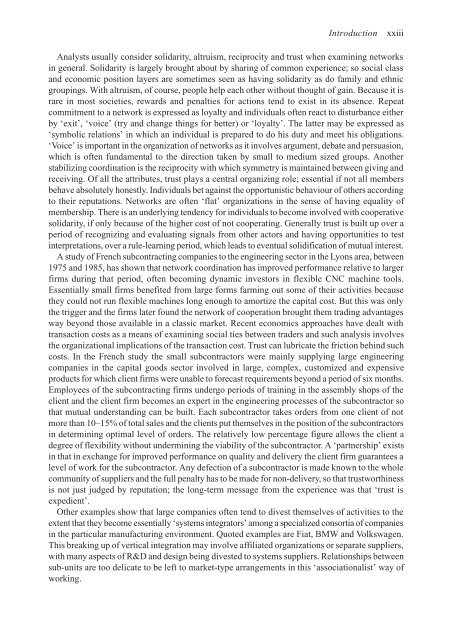Lightweight Electric/Hybrid Vehicle Design
Lightweight Electric/Hybrid Vehicle Design
Lightweight Electric/Hybrid Vehicle Design
Create successful ePaper yourself
Turn your PDF publications into a flip-book with our unique Google optimized e-Paper software.
Introduction xxiii<br />
Analysts usually consider solidarity, altruism, reciprocity and trust when examining networks<br />
in general. Solidarity is largely brought about by sharing of common experience; so social class<br />
and economic position layers are sometimes seen as having solidarity as do family and ethnic<br />
groupings. With altruism, of course, people help each other without thought of gain. Because it is<br />
rare in most societies, rewards and penalties for actions tend to exist in its absence. Repeat<br />
commitment to a network is expressed as loyalty and individuals often react to disturbance either<br />
by ‘exit’, ‘voice’ (try and change things for better) or ‘loyalty’. The latter may be expressed as<br />
‘symbolic relations’ in which an individual is prepared to do his duty and meet his obligations.<br />
‘Voice’ is important in the organization of networks as it involves argument, debate and persuasion,<br />
which is often fundamental to the direction taken by small to medium sized groups. Another<br />
stabilizing coordination is the reciprocity with which symmetry is maintained between giving and<br />
receiving. Of all the attributes, trust plays a central organizing role; essential if not all members<br />
behave absolutely honestly. Individuals bet against the opportunistic behaviour of others according<br />
to their reputations. Networks are often ‘flat’ organizations in the sense of having equality of<br />
membership. There is an underlying tendency for individuals to become involved with cooperative<br />
solidarity, if only because of the higher cost of not cooperating. Generally trust is built up over a<br />
period of recognizing and evaluating signals from other actors and having opportunities to test<br />
interpretations, over a rule-learning period, which leads to eventual solidification of mutual interest.<br />
A study of French subcontracting companies to the engineering sector in the Lyons area, between<br />
1975 and 1985, has shown that network coordination has improved performance relative to larger<br />
firms during that period, often becoming dynamic investors in flexible CNC machine tools.<br />
Essentially small firms benefited from large forms farming out some of their activities because<br />
they could not run flexible machines long enough to amortize the capital cost. But this was only<br />
the trigger and the firms later found the network of cooperation brought them trading advantages<br />
way beyond those available in a classic market. Recent economics approaches have dealt with<br />
transaction costs as a means of examining social ties between traders and such analysis involves<br />
the organizational implications of the transaction cost. Trust can lubricate the friction behind such<br />
costs. In the French study the small subcontractors were mainly supplying large engineering<br />
companies in the capital goods sector involved in large, complex, customized and expensive<br />
products for which client firms were unable to forecast requirements beyond a period of six months.<br />
Employees of the subcontracting firms undergo periods of training in the assembly shops of the<br />
client and the client firm becomes an expert in the engineering processes of the subcontractor so<br />
that mutual understanding can be built. Each subcontractor takes orders from one client of not<br />
more than 10–15% of total sales and the clients put themselves in the position of the subcontractors<br />
in determining optimal level of orders. The relatively low percentage figure allows the client a<br />
degree of flexibility without undermining the viability of the subcontractor. A ‘partnership’ exists<br />
in that in exchange for improved performance on quality and delivery the client firm guarantees a<br />
level of work for the subcontractor. Any defection of a subcontractor is made known to the whole<br />
community of suppliers and the full penalty has to be made for non-delivery, so that trustworthiness<br />
is not just judged by reputation; the long-term message from the experience was that ‘trust is<br />
expedient’.<br />
Other examples show that large companies often tend to divest themselves of activities to the<br />
extent that they become essentially ‘systems integrators’ among a specialized consortia of companies<br />
in the particular manufacturing environment. Quoted examples are Fiat, BMW and Volkswagen.<br />
This breaking up of vertical integration may involve affiliated organizations or separate suppliers,<br />
with many aspects of R&D and design being divested to systems suppliers. Relationships between<br />
sub-units are too delicate to be left to market-type arrangements in this ‘associationalist’ way of<br />
working.







